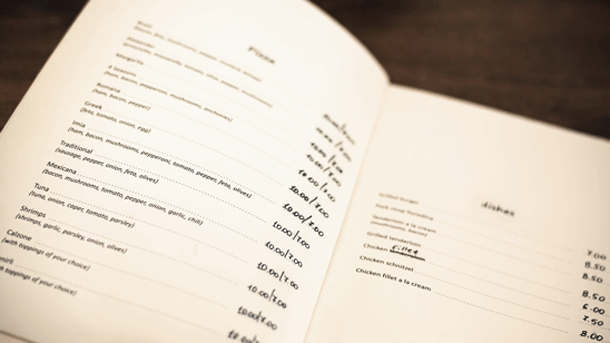
Strong marketing is one part of the story to a successful F&B business. After getting people to know your F&B outlet, the next steps are to get them to order more and then, keep them coming back.
In this article, we will be giving some pointers on how to get your customers to order more when they come to your restaurant.
Use Pictures and Icons
Pictures and icons are effective at drawing people’s attention to items on your menu. On top of that, they help improve the aesthetics of your menu and helps your customers understand your menu items better. Helping your customers to understand and familiarize with your menu encourages them to order new dishes or add ons to try out.
When people get familiar with your menu, they tend to come back to your F&B outlet again. Customers usually go back to F&B outlets that are familiar with.
Make Price a Small Issue
Your menu should always aim to get your customers to focus on what you have to offer instead of how much each item costs. Promoting cheaper deals and items may work, but not for every F&B business.
One way to divert your customer’s attention away from price would be to reduce the font size of the prices, keeping it smaller than dish names. Taking away the dollar sign is also a good way to divert your customers’ attention away from pricing to what you have to offer.
Ultimately, you want your customers to order based on what looks good instead of what is the cheapest on your menu.
Promote Your Best Selling Items
Best selling dishes are usually your best dishes. Which is what keeps your customers coming back for more. Some F&B owners feel that they should turn their promotion focus to the dishes that are not doing so well to increase sales, but you should do the exact opposite.
Keep promoting your best selling dishes to attract more returning customers, and eventually, they will try your other dishes too.
Item Placement
Position your best sellers in an equilateral triangle with the tip pointing downwards. How does the golden triangle work? Research shows that when we browse a menu, our eyes typically move to the middle first before travelling to the top right corner and then, finally, to the top left. This has been dubbed the ‘Golden Triangle’ by menu engineers.
Use colour highlights to further emphasise on these best selling dishes to capture the attention of your customers.
Use Specific Terms
Refrain from using general terms like breakfast, lunch and dinner when categorizing your dishes. Instead, group your menu items into specific categories like “Pastas”, “Steak”, “Salad”, etc. This way, you help your customers understand your menu at a glance, which is especially important if you want to keep your customers focused on what you have to offer instead of prices.
If customers are confused by your menu, they will turn to something they will never be confused about to help their ordering decision. Your pricing.
Use Digital Ordering Solutions
Digital Ordering Solutions are things like a QR code ordering system or a self ordering kiosk. Digital ordering solutions feature digital menus which removes the space constraints of a traditional physical menu, allowing you to attach appetizing images of your menu items which helps your customers understand your menu and encourages them to order dishes which are not their usual choice.
On top of that, digital ordering solutions allow you to preset add on suggestions which pop up when your customers place an order. This way, you grab every opportunity to upsell in a subtle way, which encourages customers to react positively and order more.
Getting a Digital Ordering System
If you are interested in digital ordering solutions like self ordering kiosks and QR ordering systems, drop us your contact details below and we will be happy to arrange a free demo with you.











